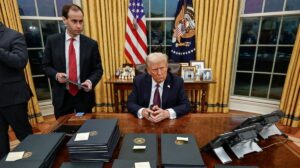In a significant effort to streamline federal governance, President Donald J. Trump has enacted a Presidential Memorandum that mandates the identification and repeal of regulations considered unlawful according to recent Supreme Court decisions. This memorandum allows agencies to bypass standard rulemaking procedures to enhance efficiency and promote competition.
Trump Targets Unlawful Regulations with New Memorandum

Trump Targets Unlawful Regulations with New Memorandum
The President's directive seeks to align federal regulations with recent Supreme Court rulings, expediting the repeal of unlawful policies.
In a decisive move to reshape the landscape of federal governance, President Donald J. Trump has issued a Presidential Memorandum directing all executive departments and agencies to identify and repeal regulations classified as unlawful under ten recent landmark decisions by the Supreme Court. This initiative builds on the framework established by Executive Order 14219, titled “Ensuring Lawful Governance and Implementing the President’s ‘Department Of Government Efficiency’ Deregulatory Initiative,” which was signed on February 19, 2025.
The memorandum emphasizes the vital need for agencies to align their regulatory frameworks with the constitutional boundaries affirmed by the Supreme Court. Landmark rulings, such as West Virginia v. EPA, Loper Bright Enterprises v. Raimondo, and SEC v. Jarkesy, have constrained the broad interpretations of agency authority, highlighting the imperative of strict adherence to legislative mandates.
In an effort to expedite this repeal process, the memorandum grants agencies permission to employ the “good cause” exception under the Administrative Procedure Act (APA). This allows them to bypass the conventional notice-and-comment rulemaking procedure when rescinding regulations inconsistent with the specified Supreme Court rulings, thus streamlining efforts to eliminate unlawful regulations and reducing bureaucratic hurdles.
Additionally, President Trump has tasked the Federal Trade Commission (FTC) with leading a government-wide initiative to eliminate or amend federal regulations that obstruct competition, entrepreneurship, and innovation. This directive goes beyond the FTC’s traditional role, aiming to extract and modify any federal regulations perceived as anticompetitive in a bid to cultivate a more vibrant and competitive economic atmosphere.
Agencies are now charged with a 60-day review process to evaluate their existing regulations against the backdrop of the cited Supreme Court rulings. After this assessment, they are expected to promptly repeal or revise any regulations that surpass statutory authority or are otherwise considered unlawful. This coordinated effort underscores the administration's commitment to ensuring that federal regulations operate within the bounds of constitutional and legislative frameworks.
In sum, President Trump’s new directive signifies a pivotal shift toward strengthening the rule of law in federal regulatory practices. By aligning agency operations with recent Supreme Court decisions and expediting the repeal of unlawful regulations, the administration aspires to establish a more accountable, constitutionally-driven federal bureaucracy.























